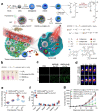Smart Biomimetic Nanozymes for Precise Molecular Imaging: Application and Challenges
- PMID: 37259396
- PMCID: PMC9965384
- DOI: 10.3390/ph16020249
Smart Biomimetic Nanozymes for Precise Molecular Imaging: Application and Challenges
Abstract
New nanotechnologies for imaging molecules are widely being applied to visualize the expression of specific molecules (e.g., ions, biomarkers) for disease diagnosis. Among various nanoplatforms, nanozymes, which exhibit enzyme-like catalytic activities in vivo, have gained tremendously increasing attention in molecular imaging due to their unique properties such as diverse enzyme-mimicking activities, excellent biocompatibility, ease of surface tenability, and low cost. In addition, by integrating different nanoparticles with superparamagnetic, photoacoustic, fluorescence, and photothermal properties, the nanoenzymes are able to increase the imaging sensitivity and accuracy for better understanding the complexity and the biological process of disease. Moreover, these functions encourage the utilization of nanozymes as therapeutic agents to assist in treatment. In this review, we focus on the applications of nanozymes in molecular imaging and discuss the use of peroxidase (POD), oxidase (OXD), catalase (CAT), and superoxide dismutase (SOD) with different imaging modalities. Further, the applications of nanozymes for cancer treatment, bacterial infection, and inflammation image-guided therapy are discussed. Overall, this review aims to provide a complete reference for research in the interdisciplinary fields of nanotechnology and molecular imaging to promote the advancement and clinical translation of novel biomimetic nanozymes.
Keywords: magnetic resonance imaging; molecular imaging; multimodal imaging; nanozymes; photoacoustic imaging; positron emission tomography.
Conflict of interest statement
The authors declare no conflict of interest.
Figures









References
Publication types
Grants and funding
LinkOut - more resources
Full Text Sources
Miscellaneous

